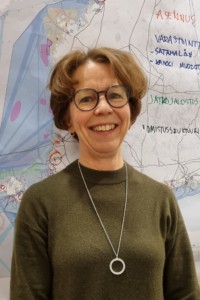Maritime spatial planning to promote offshore energy production
Geopolitical conflict transformed the status and outlook for offshore energy production last year. The EU’s latest strategic objectives for offshore renewable energy production require technological development and test the agility of maritime spatial planning and its ability to adapt to new circumstances. Ann Holm, a Director of Regional Planning at the Regional Council of Ostrobothnia, has been considering sustainable offshore energy production and where production plants could be built in Finland’s sea areas.

Maritime spatial planning promotes sustainable offshore energy production and reconciles the needs of energy production with the other uses of marine areas. The eMSP NBSR project arranged a Sustainable Blue Economy workshop in The Hague in November 2022. The event brought together experts and developers from the North Sea and Baltic Sea regions. The aims included fostering an understanding of the outlook for offshore energy production and technological innovations. A further aim was to consider ways of building trust between marine operators and maritime spatial planners.
“In addition to offshore wind power, other forms of marine energy production, including solar, wave and tidal power, are now under discussion in the North Sea and southern Baltic Sea areas. In Finland, the sea freezes in the winter, so the conditions this far north differ significantly from those in other sea areas, and the various forms of energy production require technological development to progress,” says Ann Holm, whose responsibilities include regional land use planning and maritime spatial planning in Quark and Northern Bothnian Sea.
“The most fruitful part of expert meetings and encounters with other planners is the opportunity to share common problems and potential solutions,” says Holm. Understanding the marine conditions and the different approaches to planning are important for cooperation.
The European Green Deal is the key instrument of the European Union’s energy and climate policy. The target for the production of renewable energy in the open sea is 340 GW by 2050, and the Baltic Sea is considered one of the main areas for offshore wind energy production. In response to the Ukraine War, the European Commission presented its RePowerEU strategy in 2022. The strategy calls for Europe to decouple itself from its reliance on Russian fossil fuels, requiring a rapid transition to renewable energy production of up to 45% by 2030. According to Ann Holm, there is good reason to consider an overall energy production solution in Finland’s maritime areas as well.
“Development focuses on offshore wind power, but it is also important to consider the opportunities presented by wave and solar power, as well as electricity storage and transmission. It is important to plan and prepare the various activities at the same time and think about monitoring carefully and in the early stages,” emphasises Holm. “It is also wise to consider multiuse marine areas, called MariParks, where operators can enjoy synergies, the public and private sectors work together, and, for example, environmental impact assessment and permit processes could be combined.”
“Interest in and pressure for offshore wind power is currently focused on the economic zone. As regards the territorial waters, the Ostrobothnia regional land use plan for 2050 will allocate as much space as possible to offshore wind power, but it will be challenging to reconcile this with fishing and shipping, in particular,” Holm says and continues that “the impact of offshore wind power construction on migratory fish must also be examined.”
Maritime spatial planning is considered a key planning tool for increasing the offshore wind power capacity in Europe. Ensuring the various elements of sustainability and coordinating offshore wind power with other marine activities and the protection of marine nature are at the heart of maritime spatial planning. Maritime spatial planning is a way of anticipating change, enabling synergies, and preventing conflicts between policy priorities.
“Building social trust between planners and stakeholders, as well as among stakeholders, is an important step in facilitating sustainable planning,” says Holm. She points out that stakeholder representatives must listen to and understand each other better.
“Maritime spatial planning has served as a meeting place and forum for various stakeholders for many years, and this work will continue into the second planning cycle. Interaction from the outset of the process is important for reconciling the various activities and for the approval of the plan,” says Holm.
Finland’s maritime spatial planning authorities are involved in a joint maritime spatial planning project covering the Baltic Sea and the North Sea. The project is known as eMSP NBSR. One of the key activities under the project is to support sustainable blue economy through maritime spatial planning. Website of the Sustainable Blue Economy Learning Strand, which is part of the eMSP NBSR project: https://www.emspproject.eu/project-activities/community-of-practice/sustainable-blue-economy/
The National Maritime Spatial Planning and Marine Energy Production workshop was held in Vaasa on 14 December 2022 with a group of expert participants. The presentations given at the event and a summary of the event will be published at www.merialuesuunnittelu.fi in early 2023.


